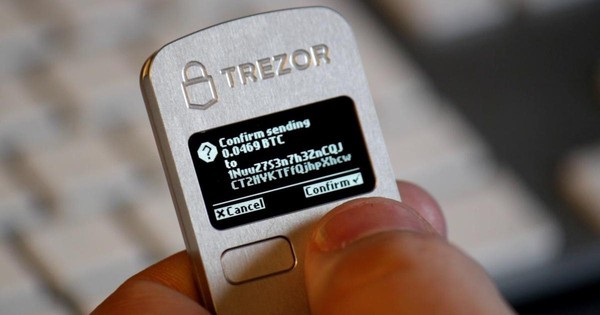Bitcoin thief from the hands of the FBI
- Tram Ho
The “hard wallet” containing hundreds of millions of dollars worth of Bitcoin is still lying in the safe of the US Federal Bureau of Investigation (FBI), but the money in the wallet is still “evaporating”.

Gary Harmon grinned as he sat in a bathtub full of green coins, surrounded by girls in skimpy clothes. This picture on the phone could be evidence against Gary: where did he get so much money from?

The photo denounces Gary Harmon. Source: District of Columbia Courts
Gary faces a very strange crime: remotely stealing 713 Bitcoins, then worth nearly $5 million, now nearly tripled, from a “hard wallet” that US authorities confiscated in the case in which his brother, Larry Harmon, was the culprit.
Brother is also bad
Larry Harmon, Gary’s brother, is the CEO of Bitcoin Mixer Helix. This company specializes in providing the service of “mixing” blockchain transactions together to make the transaction untraceable.
The original purpose of this “mixing” method was to increase the security and anonymity of the trader, but was quickly used by criminals to launder money.
In 2011, Larry pleaded guilty to laundering $311 million through multiple cryptocurrency transactions. Illegal amounts of virtual currency stored in a device called a “hard wallet” were also confiscated and kept in an evidence safe. Assume that the money is safe.
But not!
When the investigation team checked the wallet again, they were shocked to realize that 713 Bitcoins had “flyed without wings”. This thief even used two different transaction mixing services to completely conceal the information.
Larry swore to death that he had nothing to do with the “evaporation” of 713 Bitcoins, and also “indicated” the FBI to arrest his brother. Gary is currently in jail awaiting trial, and his brother is out on bail.
The two Harmon brothers’ cases show that the US government is successful in gathering evidence of crimes, but still faces a challenge: how to freeze liquid assets like Bitcoin?
Trading tricks in the field of virtual currency
In 2014, Larry created Grams – a machine that helps users scour the darknet (a system of websites that cannot be accessed by search engines) for illegal drugs, guns and hacker services. They can then pay through a “mix-up” service also run by Larry called Helix. Larry earns 2.5% on each trade.
Business flourished. In 2016, AlphaBay, the largest darknet network at the time, began driving customers to Helix, but this also alarmed US authorities.
The FBI pretends to be a Helix user to reach Larry. In July 2017, AlphaBay was shut down due to being a large distribution market for drugs, but the FBI has yet to track down who runs Helix. Larry stopped the virtual currency mixing service at the time when it was doing 356,000 Bitcoin transactions.
It is hard to believe that the person behind Helix is the developer of Dropbit – the application Larry introduced is the “Venmo of virtual money”. He constantly encourages people to use Bitcoin and his company Coin Ninja. He even posted a video on Twitter, showing off his Bitcoin hat, shirt and socks.

Larry Harmon in Bitcoin hat and sweater. Image source: Twitter
Find the culprit
Bitcoin transactions are performed on a blockchain – a publicly viewable database online. No trading account name, just a long string of letters and numbers that look random. This makes the transaction appear to leave no trace, but when users try to exchange Bitcoins for physical objects, they will be exposed.
Larry made a mistake here, he used his personal email to open an account on the website that allows buying gift cards with Bitcoin. The FBI investigates and suspects Larry’s financial ability. Searching through the photos he uploaded to the cloud, they found a photo taken with Google Glass: the Helix admin page.
After you come to me
In early 2020, Larry was arrested at his office in Akron (Ohio). The FBI also seized the Trezor hardware wallet containing the Bitcoin codes, but they could not open it because there was no password. The point is, this hardware wallet can be accessed by another device, as long as the passcode is known and an additional PIN is known. It makes no sense to disconnect the hardware wallet and put it in the safe.
And that’s how the younger brother Gary pulled money out of the hardware wallet before the helplessness of the FBI. Only when Larry handed over the password, and the FBI transferred the remaining 4,164 Bitcoins to another safe wallet, the thief stopped.
Not as discreet as his brother, Gary left quite a few clues, from emails from wallet address Trezor no-reply@trezor.io to pictures showing money in the bathtub. Yet he still denied the crime, saying: “If I steal, why don’t I steal everything?”. Gary turned down two plea offers from the prosecutor to reduce his sentence.
Like his brother, Gary applied for bail to be released, but the prosecutor made the condition that he must give the password to turn over the remaining Bitcoins. Gary’s lawyer said: “The government’s failure to keep up with technology is not the defendant’s problem.”
Gary’s trial is scheduled for February next year.
Source : Genk
